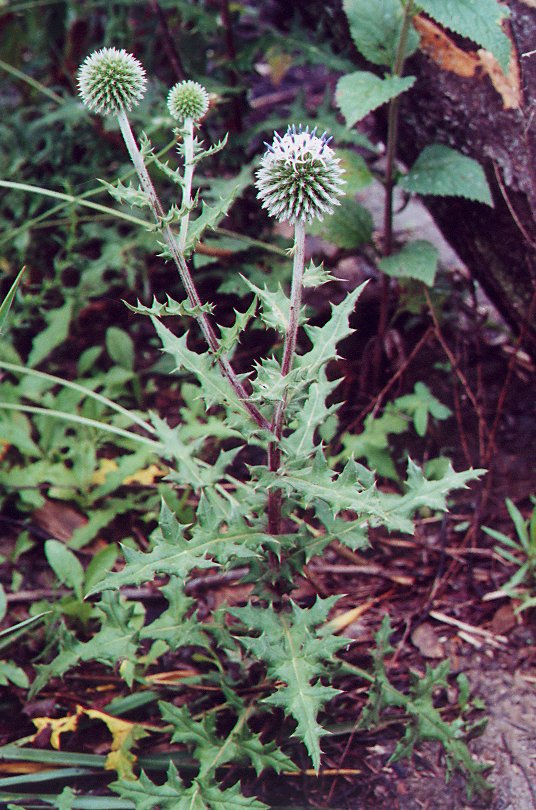Echinops sphaerocephalus L.
Great Globethistle

Introduced
CC = n/a
CW =
MOC = 0
© DETenaglia
Echinops sphaerocephalus L.Great Globethistle | |
 |
Introduced CC = n/a CW = MOC = 0 |
© DETenaglia |
|
Family - Asteraceae/Cardueae Stems - To +60cm tall, erect, herbaceous, from thickened roots or short caudex, branching above, with a dense covering of whitish vertically oriented arachnoid pubescence and also glandular pilose. Glandular pubescence often purplish to ferruginous. Leaves - Alternate, sessile, clasping, pinnately lobed, reduced above, to 20cm long, +/-8cm broad, dense arachnoid pubescent below, pubescent (some glandular) above. Margins with spines, often revolute.
Inflorescence - Terminal globose determinate cluster of flower heads terminating stems. Cluster to +/-4cm in diameter, enlarging in fruit. Flowers single per flower head. Inflorescence of +/-100 flower heads.
Involucre - Phyllaries loose, stiff, lance-attenuate, greenish to bluish in apical half, scarious and fimbriate basally, to +/-6mm long, often glandular, +/-15 per flower head. Ray flowers - Absent. Disk flowers - Corolla tube 4mm long, lilac-whitish, glabrous, 5-lobed. Lobes spreading to slightly recurved, linear, 6-7mm long, glabrous. Stamens 5, adnate to base of corolla lobes, exserted. Filaments purplish, 1mm long. Anthers connate around style, 4-5mm long, deep blue-purple. Style white, glabrous. Stigmas pubescent at base, 2.1mm long. Achenes (in flower), pubescent, 3.2mm long, enlarging in fruit to 1cm long, weakly 4-5angled or terete. Pappus a small crown of minute bristlelike scales to -1mm long.
Flowering - June - September. Habitat - Cultivated. Origin - Native to Europe. Other info. - This plant won't be found in the wilds of Missouri yet but it is commonly cultivated and quite striking. The large globular flower clusters are hard to miss in the garden landscape. The plant prefers dry hard ground in a sunny location. Photographs taken at the Kansas City Zoo, 7-15-00. |